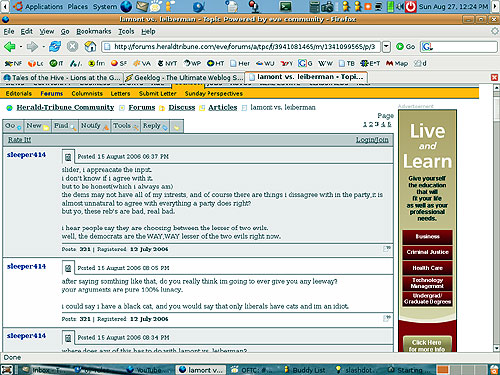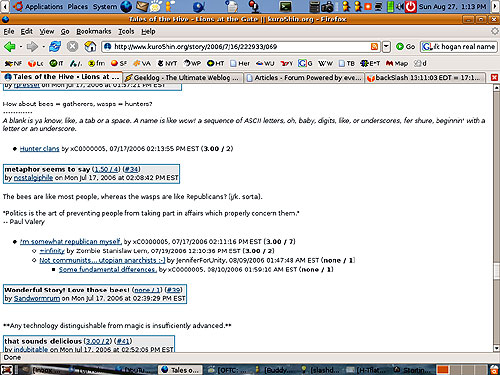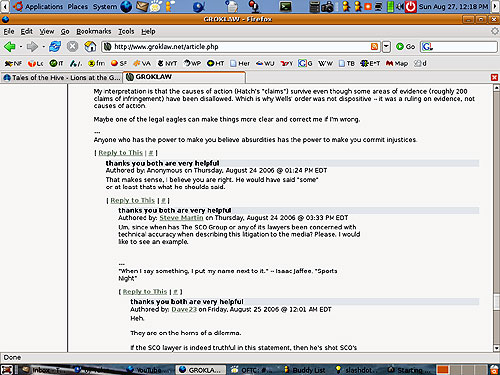[Editor’s note: Robin ‘Roblimo’ Miller is Editor in Chief of OSTG. He has also written three books about computing and the Internet and wrote hundreds of freelance articles for assorted newspapers and magazines before he learned how to make a living on the Internet. Miller also is a member of OJR’s new editorial advisory board.]
I often shudder at the poor quality of online forums run by newspapers and other local media outlets. Come on, people! This reader interaction thing may be new to you, but some of us have been doing it for 10 or 15 years, and have a pretty good idea of what works and what doesn’t.
This article outlines five basic rules for building sustainable online communities that are based on my 15+ years of experience with various online services, discussion groups, usenet forums, and — for the last seven years — as part of the management team behind the famous Slashdot discussion site. I’m not saying that you should follow slavishly in my footsteps, but I assure you that a forum you build (or rebuild) in accordance with my rules will be more popular, easier to manage, and more profitable than one that doesn’t follow them. These rules — and the software that helps enforce them — are the driving force behind hundreds of popular and profitable discussion-based Web sites.
Rule One:
Your discussions must be threaded or nested, not just “flat.”
A flat discussion tags the newest comments onto either the top or the bottom of ones already listed. A threaded discussion shows “discussion threads” but doesn’t display the entire content of posts replying to “parent posts,” just their subject headers.
The Sarasota (Florida) Herald-Tribune has “flat” message boards. In this example, a poster has replied to three other posts, but the new posts are not associated directly with the ones to which they are replying. This discussion had 62 posts at the time this screenshot was taken, and it was almost impossible to follow any of the sub-conversations within it because of the way it was displayed.

Kuro5hin is a “geek interest” news and discussion site that uses software based on Slashdot’s. This screenshot shows part of a 62-message discussion displayed in “threaded” mode.

Groklaw discusses legal issues related to free software. This example of “nested” discussion display is part of a string of over 300 reader comments attached to one article. Slashdot and Groklaw routinely run articles that draw 1000+ reader responses. Threading, nesting or some other sorting mechanism is necessary to keep discussions this large from becoming unintelligible.

Even in small discussions (20 or fewer posts), conversations are easier to follow if new comments are linked directly to comments they are responding to than if they are displayed in the order in which they were submitted.
Without reader-to-reader conversations, an online forum is nothing but a giant “letters to the editor” page. While posting responses to your published stories gives your readers more voice than they’d have without this ability, your forums or bulletin boards (or whatever you want to call them) will only achieve their full potential when readers start using them to talk directly to each other instead of merely reacting to content you have posted.
Rule Two:
You have readers who know more than you do about any given topic — and plenty of readers who don’t know nearly as much as they think they do.
I’ve been writing online long enough to realize that I should be be thankful for readers’ corrections and accept them graciously instead of letting them upset me. It takes a while to accept the constant barrage of criticism and nitpicking you get if you have reader comments attached directly to all articles on your site, but in the end you and your fellow writers will become more careful reporters.
One thing many online writers have noticed over the years is that compliments are more likely to be sent to you by private email, while critical comments are more likely to be posted on public boards. I’ve also noticed — speaking strictly from my own experience — that unfair public attacks from uninformed or mindlessly vituperative readers almost always draw rebuttals from other, more knowledgeable readers. I have learned not to get into arguments with readers who attack my online work in public, but to trust other readers to come to my defense if I have been wronged.
Of course, if I make a factual error or grammatical mistake and a reader posts a comment about it, the right thing to do is post something along the lines of, “Corrected. Thanks for noticing.”
This makes it clear to the readers that I pay attention to posts attached to articles published under my byline, and makes it even more clear that I respect my readers and happily give them credit if they give me informed criticism that helps improve my work.
The only problem with this philosophy is that it can be hard to separate experts from yow-yowers, especially if you’ve written about a topic area in which you are not an expert. But that’s why we have…
Rule Three:
Let your readers judge each other so you don’t have to judge them yourself.
Slashdot, Groklaw, Kuro5hin and many other geek-oriented discussion sites have moderation features built into the software that drives them. Slashdot’s moderation scheme, from which the others were derived, works like this:
- You cannot post in and moderate the same discussion; you cannot, therefore, moderate your own posts.
- Moderation powers are distributed semi-randomly, and only to readers who have had login identities for at least a few weeks. And no individual reader gets more than a few moderation points at a time, so it’s hard for one knucklehead to mess up the whole scheme.
- Obscenities, personal attacks, and other unwelcome speech will almost inevitably be moderated down into oblivion. “Community standards” have been used as a legal test of what constitutes obscenity. Give your readers the power to moderate other readers’ posts, and you will soon find what they consider obscene.
Slashdot has tried all sorts of additions and tweaks to its moderation system over the years, so many that a pretty good percentage of the Slashdot FAQ (Frequently Asked Questions) page is dedicated to comments and moderation.
The point of moderation is to separate dreck from diamonds. Readers who aren’t logged in view Slashdot comments that are rated +1 or above (on a -1 to +5 scale) but do not see comments rated 0 or -1 without special effort. Logged-in users’ comments post automatically at the +1 level, while comments from readers who are not logged in start at 0. A post from someone who is not a logged-in user, therefore, needs at least one logged-in reader to consider it worthy of a positive moderation point before most readers can see it at all, while a post from logged-in user that a few users who have moderation powers that day find offensive can easily drop from public view.
On the positive side, comments that add something useful to the discussion will be moderated upwards, so readers who only want to see the most cogent comments can set their preferences so that they see only comments moderated to +2, +3 or even +5.
On the negative side, you may want to give readers a little help. Most Slashdot-type posting systems allow employees or other selected forum monitors extra moderation privileges so that they can save readers from the task of removing strings of especially vituperative comments.
You may also want to only allow comments from registered, logged-in users. Slashdot allows anonymous comments because of the “whistle blower” factor; some of the site’s best posts have always come from people who might lose their jobs if they posted inside information about their employers’ actions under a traceable name. In return for occasional anonymous gems, Slashdot suffers from plenty of anonymous garbage down at the 0 and -1 moderation levels. You may decide this tradeoff isn’t worthwhile, and I won’t blame you if you take the easier course. I often wish we’d taken it ourselves.
In any case, you need to realize that your forums will need some watching and nurturing if they are ever going to become a valuable part of your online offerings.
Rule Four:
All good things must come to an end.
You can’t leave online conversations “open” forever. Sooner or later you need to close them off, if only to keep comment spam from taking over posting threads on older stories. You may chose to allow comments on stories for as long as 30 days, although you’re probably better off closing comments on most stories after a week or two if you publish weekly, daily or constantly.
Archiving older discussions as static pages instead of serving every completed conversation on your site as a dynamic page can also save dramatically on server usage, which will help keep costs down.
Rule Five:
Why buy a cow when the software is free?
By now you’re probably saying, “Whoa, man… where can I buy the cool software that runs Slashdot?”
I’m sorry. We don’t sell Slash. We give it away. For free. Right here. The only caveat is that if you figure out a way to make Slash run better or more efficiently, we ask you to share your improvements with us and other people who use Slash under the terms of the GNU General Public License.
Scoop, the code that runs Kuro5hin, is also freely available, as is the Geeklog software behind Groklaw. And these are just a few of the best-known free content management systems out there that have Slashdot-like comment and moderation systems. There are many others. Slash is far from the easiest one to install, customize, and maintain, but it is also the most proven one for sites that may deal with millions of pageviews and tens of thousands of comments every day. Your IT people or hosting people may already have a favorite piece of free forum software; if so, that might be your best choice as long as that software is already being used successfully to power sites at least as large as yours is likely to become in the foreseeable future.
But the main thing isn’t the software. It’s your (and your management’s) attitude. It is not easy to give readers near-total control over some of your vital Web real estate. There is an endless temptation to do things like create topics you think will interest readers instead of letting your readers choose what to discuss on their own.
Communities aren’t created by management fiat. They grow on their own. You can provide a fertile environment for yours, and nurture it with light-handed moderation and by having staff members participate in its early conversations.
Note that I haven’t mentioned blogs as a factor in any of this. A reader-driven forum that allows users to start new topic threads gives readers the option of posting entries that are similar enough to blogs that calling some threads “blogs” becomes redundant.
And when it comes to staff members blogging… perhaps I’m showing my age here, but I remember when the people we now call “bloggers” were called “columnists.” But that’s another discussion for another time.








